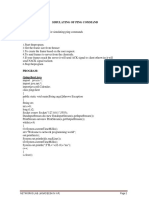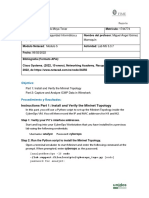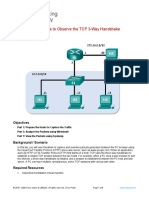Arti 16
Arti 16
Uploaded by
vidit mehtaCopyright:
Available Formats
Arti 16
Arti 16
Uploaded by
vidit mehtaOriginal Title
Copyright
Available Formats
Share this document
Did you find this document useful?
Is this content inappropriate?
Copyright:
Available Formats
Arti 16
Arti 16
Uploaded by
vidit mehtaCopyright:
Available Formats
VDOM
Chapter 9Labs
- Troubleshooting the BIG-IP System 9-1
3-7
Lab 9.2 - SNMP Alerts and Traps
Objectives:
Configure the BIG-IP system to send traps to an SNMP management console and view trap
messages using tcpdump
Estimated time for completion: 25 minutes
Lab Requirements:
Although there is no SNMP management console in the classroom, you can designate your PC as
an SNMP trap destination, and then use tcp dump to view the output from SNMP traps.
Configure Traps
Configure a destination for traps
1. Configure a destination for traps triggered on BIG-IP. Choose to use EITHER the
Configuration utility (a) OR tmsh (b) to carry out this step.
a. Use the Configuration utility to set up a trap destination….
Configuration utility
System » SNMP »Traps » Destination and click Create
Record Properties section
Version v1
Community Public (with a capital “P”)
Destination 10.10.X.30
Port 162
When complete, click Finished
b. …OR use tmsh to set up a trap destination and display the results, then quit tmsh.
(Substitute your station number for “X” in both locations.) For example:
(tmos)# modify /sys snmp v1-traps add { tsX {host 10.10.X.30
community Public} }
(tmos)# list /sys snmp
1 VDOM Labs www.vdomlabs.com
Administering BIG-IP v11 9-1
3-7
VDOM
9-2 Labs Chapter 9 - Troubleshooting the BIG-IP System
3-7
Prepare to view trap messages
2. Use an existing or open a new SSH session to the BIG-IP system, and log in as root.
3. Start tcpdump to capture your trap traffic.
config# tcpdump –ni external –Xs 200 udp and host 10.10.X.30 and port 162
Cause traps to be triggered
4. Change the receive string of the My_HTTP monitor such that it marks all the pool members in
http_pool down.
Q. Did trap messages appear immediately in your tcpdump output? Why or
why not?
5. On your tcpdump window, press the <Enter> key several times to insert some space between the
previous set of trap messages and any new ones that are generated.
6. Change the receive string of the My_HTTP monitor again such that it marks all the pool
members in http_pool up again.
Q. Did trap messages appear immediately in your tcpdump output? Why or
why not?
7. Stop your tcpdump by pressing<Ctrl-C>.
8. Go look at the SNMP alerts that are pre-configured on BIG-IP.
config# less /etc/alertd/alert.conf
Optional tcpdump Lab Steps
Use the tcpdump command to examine BIG-IP local traffic:
9. Capture the traffic between BIG-IP and the pool member 172.16.20.2:80. Once you start the
tcpdump, open a session with http://10.10.X.100 and refresh the screen a few times. How
frequently does the TCP connection (syn/syn-ack/ack) appear in your tcpdump output? Is the
TCP connection process apparent?
10. Capture the traffic between your PC and BIG-IP on port 22 (SSH). Limit the number of packets
that are captured. Did your tcpdump output show a connection process?
2 VDOM Labs www.vdomlabs.com
9-2 Administering BIG-IP v11
3-7
VDOM Labs 3-7
Expected results and troubleshooting
As with the remote syslog server lab, when you configured the My_HTTP monitor such that the health
check would fail for all pool members, you had to wait for the period defined by the monitor’s timeout
value before the log messages are generated that trigger the SNMP trap messages. However, when you
reset My_HTTP to allow for a successful test to all pool members, as soon as the BIG-IP system receives
a successful test response, he marks the pool member available. As statuses change, a series of local
traffic log messages are written that, in turn, trigger more SNMP trap messages.
Depending on how far down in the alert.conf file you scrolled, you may or may not have come across the
SNMP traps that relate to an LTM virtual server becoming unavailable or available.
Clean-up at end of lab
11. Delete the SNMP trap destination 10.10.4.30 you created at the start of this lab. Use the same
method as you used to create the destination: either the GUI (System » SNMP : Traps :
Destination) or tmsh: tmsh modify /sys snmp v1-traps delete { tsX}
(Optional) Continue with Lab 9.3: Remote Syslog Server Lab
Administering BIG-IP v11 11-9
3 VDOM Labs www.vdomlabs.com
3-7
You might also like
- 12.CEH Module 3 Assignment 3.1Document7 pages12.CEH Module 3 Assignment 3.1piyuhNo ratings yet
- Arti 17Document4 pagesArti 17vidit mehtaNo ratings yet
- (Optional) Simple Network Management Protocol (SNMP) : COSC301 Laboratory ManualDocument15 pages(Optional) Simple Network Management Protocol (SNMP) : COSC301 Laboratory ManualpruevaNo ratings yet
- Fire Up Cpan On UbuntuDocument17 pagesFire Up Cpan On UbuntuHarguilar NhangaNo ratings yet
- Laboratorio IDSDocument13 pagesLaboratorio IDSJotaceeNo ratings yet
- Lab 10: IDPS - Snort & Cisco IDPS Sensors: 9.1 DetailsDocument24 pagesLab 10: IDPS - Snort & Cisco IDPS Sensors: 9.1 DetailsewNo ratings yet
- TCP Attack LabDocument13 pagesTCP Attack LabD CREATIONNo ratings yet
- Test VM Network Throughput by Using NTTTCP - Microsoft LearnDocument5 pagesTest VM Network Throughput by Using NTTTCP - Microsoft LearnaquaherthaNo ratings yet
- SNMP Doc2Document4 pagesSNMP Doc2tabreNo ratings yet
- Using Wireshark To Observe The TCP 3-Way HandshakeDocument8 pagesUsing Wireshark To Observe The TCP 3-Way HandshakeIshmael BatumbakalNo ratings yet
- Lab 1 SNMP-Wireshark BasicsDocument13 pagesLab 1 SNMP-Wireshark BasicsMary Amirtha Sagayee. GNo ratings yet
- Snort and Firewall Rules-1Document9 pagesSnort and Firewall Rules-1Ruel AlejandroNo ratings yet
- MRTG SetupDocument11 pagesMRTG SetupRaaz FriendNo ratings yet
- Protocols For Data Networks (Aka Advanced Computer Networks)Document17 pagesProtocols For Data Networks (Aka Advanced Computer Networks)Hedy PamungkasNo ratings yet
- 26.1.7 Lab - Snort and Firewall RulesDocument8 pages26.1.7 Lab - Snort and Firewall RulesRana Elwan100% (1)
- 5.2.2.6 Lab - Configuring SNMPDocument12 pages5.2.2.6 Lab - Configuring SNMPRyan Johnson0% (1)
- CN Lab Manual-2-60Document59 pagesCN Lab Manual-2-60alps2coolNo ratings yet
- Configuring SNMP Event MonitoringDocument4 pagesConfiguring SNMP Event Monitoringarun0076@gmail.comNo ratings yet
- Configuring SNMP For ACI - LEARN WORK ITDocument14 pagesConfiguring SNMP For ACI - LEARN WORK ITravi kantNo ratings yet
- Adding Devices To Cacti Monitoring SystemDocument6 pagesAdding Devices To Cacti Monitoring SystemJh0n Fredy HNo ratings yet
- 26.1.7 Lab - Snort and Firewall Rules - ILMDocument9 pages26.1.7 Lab - Snort and Firewall Rules - ILMmarlonkillianlouisaNo ratings yet
- ICL TroubleshootingDocument17 pagesICL TroubleshootingnokiasieNo ratings yet
- Lab 1Document9 pagesLab 1Dihia RaabNo ratings yet
- 26.1.7 Lab - Snort and Firewall RulesDocument8 pages26.1.7 Lab - Snort and Firewall RulesFata HasanNo ratings yet
- 5.2.2.6 Lab - Configuring SNMPDocument12 pages5.2.2.6 Lab - Configuring SNMPMakais Mckay100% (6)
- Deasis Tech6Document9 pagesDeasis Tech6Mariah De asisNo ratings yet
- Práctica de Laboratorio 26.1.7Document10 pagesPráctica de Laboratorio 26.1.7rojas.saldana.armando.sptmNo ratings yet
- CN ManualDocument76 pagesCN Manual30922No ratings yet
- 5.3.7 Lab - Introduction To Wireshark - Es XLDocument13 pages5.3.7 Lab - Introduction To Wireshark - Es XLJeelon MTNo ratings yet
- Lab 05 SNMP Cisco Routers PDFDocument14 pagesLab 05 SNMP Cisco Routers PDFFarhan AltafNo ratings yet
- 26.1.7lab - Snort and Firewall RulesDocument7 pages26.1.7lab - Snort and Firewall RulesThái NguyễnNo ratings yet
- 5.2.2.6 Lab - Configuring SNMPDocument12 pages5.2.2.6 Lab - Configuring SNMPHenri KelderNo ratings yet
- CN Lab Manual Format EDITEDDocument32 pagesCN Lab Manual Format EDITEDthamizhini senthilNo ratings yet
- Practical SheetDocument20 pagesPractical SheetThiliniNo ratings yet
- Introduction To Node-Red v2Document22 pagesIntroduction To Node-Red v2Mohd AsyrafNo ratings yet
- Huytqse182122 - 9.2.6 Lab - Using Wireshark To Observe The TCP 3 Way HandshakeDocument6 pagesHuytqse182122 - 9.2.6 Lab - Using Wireshark To Observe The TCP 3 Way Handshakehuytqse182122No ratings yet
- SNMP AgentDocument4 pagesSNMP AgentNani2220No ratings yet
- IPD CMLviaDevNetSandboxDocument9 pagesIPD CMLviaDevNetSandboxBaki GucluNo ratings yet
- Kammavari Sangam ® K.S.Institute of Technology: Computer Communication Networks Lab 15TEL77Document63 pagesKammavari Sangam ® K.S.Institute of Technology: Computer Communication Networks Lab 15TEL77badboyNo ratings yet
- 12.1.1.7 Lab - Snort and Firewall Rules PDFDocument9 pages12.1.1.7 Lab - Snort and Firewall Rules PDFInteresting facts ChannelNo ratings yet
- 9.2.6 Lab - Using Wireshark To Observe The TCP 3-Way HandshakeDocument6 pages9.2.6 Lab - Using Wireshark To Observe The TCP 3-Way Handshakeakmal nadyaNo ratings yet
- 28.1.3 Lab - Use The Netmiko Python Module To Configure A Router - ITExamAnswersDocument11 pages28.1.3 Lab - Use The Netmiko Python Module To Configure A Router - ITExamAnswersAndres Esteban AreasNo ratings yet
- Network Security Lab ManualDocument71 pagesNetwork Security Lab ManualSankalp Balannavar100% (1)
- leNguyenWinHoi21it350-17 04Document12 pagesleNguyenWinHoi21it350-17 04ble049917No ratings yet
- Lan Assignment 24Document17 pagesLan Assignment 24joyceopk04No ratings yet
- Green Networks: Introduction To MininetDocument6 pagesGreen Networks: Introduction To MininetnshivegowdaNo ratings yet
- Backtrack 1Document7 pagesBacktrack 1candrayusNo ratings yet
- 28.1.3 Lab - Use The Netmiko Python Module To Configure A Router - ILMDocument11 pages28.1.3 Lab - Use The Netmiko Python Module To Configure A Router - ILMTRYST CHAMANo ratings yet
- CR Channel Notching v13 3Document3 pagesCR Channel Notching v13 3kanagaraj2331993No ratings yet
- Oaisim WalkthroughDocument7 pagesOaisim Walkthroughselvakumar2k2No ratings yet
- 12.1.1.7 Lab - Snort and Firewall RulesDocument9 pages12.1.1.7 Lab - Snort and Firewall RulesMuhammad TaufiqNo ratings yet
- Snmp-Server Enable Traps: Notification-TypeDocument100 pagesSnmp-Server Enable Traps: Notification-TypeWagner HilarioNo ratings yet
- 9.2.6 Lab - Using Wireshark To Observe The TCP 3-Way HandshakeDocument7 pages9.2.6 Lab - Using Wireshark To Observe The TCP 3-Way HandshakePrince NagacNo ratings yet
- An Express Guide SNMP For Secure Rremote Resource MonitoringDocument5 pagesAn Express Guide SNMP For Secure Rremote Resource MonitoringAbhishekKrNo ratings yet
- Lab7 OpensflowDocument11 pagesLab7 OpensflowAllan Pitter PressiNo ratings yet
- ProgramsDocument41 pagesProgramsHimanshu ShekharNo ratings yet
- CTF - Kioptrix Level 1 - Walkthrough Step by Step: @hackermuxam - Edu.vnDocument16 pagesCTF - Kioptrix Level 1 - Walkthrough Step by Step: @hackermuxam - Edu.vnNguyenDucNo ratings yet
- Backtrack 1Document7 pagesBacktrack 1candrayusNo ratings yet
- CISCO PACKET TRACER LABS: Best practice of configuring or troubleshooting NetworkFrom EverandCISCO PACKET TRACER LABS: Best practice of configuring or troubleshooting NetworkNo ratings yet
- Arti 25Document3 pagesArti 25vidit mehtaNo ratings yet
- Arti 10Document8 pagesArti 10vidit mehtaNo ratings yet
- Blocking Mask SettingsDocument3 pagesBlocking Mask Settingsvidit mehtaNo ratings yet
- Never (Wildcard Only)Document5 pagesNever (Wildcard Only)vidit mehtaNo ratings yet
- Palo Alto API Through XMLDocument2 pagesPalo Alto API Through XMLvidit mehtaNo ratings yet
- Command Line SiaDocument14 pagesCommand Line Siavidit mehtaNo ratings yet
- F5 ASM Course ContentDocument20 pagesF5 ASM Course Contentvidit mehtaNo ratings yet
- F5 LTM Course ContentDocument16 pagesF5 LTM Course Contentvidit mehtaNo ratings yet
- F5 - LTM - Course - Outline - DraftDocument6 pagesF5 - LTM - Course - Outline - Draftvidit mehtaNo ratings yet
- F5 ASM TrainingDocument3 pagesF5 ASM Trainingvidit mehtaNo ratings yet
- Types of VS F5Document8 pagesTypes of VS F5vidit mehtaNo ratings yet
- Integrated Management Module Error MessagesDocument25 pagesIntegrated Management Module Error MessagesTofan Dwi ArtaNo ratings yet
- DownloadDocument8 pagesDownloadanfal azamNo ratings yet
- C++ Assignment, PointersDocument8 pagesC++ Assignment, PointersAreeb AliNo ratings yet
- Swift Copy Black Transfer BCM - 500M 23102024-1Document2 pagesSwift Copy Black Transfer BCM - 500M 23102024-1mahmoudalzoubidiNo ratings yet
- Troubleshooting SlidesDocument64 pagesTroubleshooting Slidesjimcaalefaarax4No ratings yet
- Projecr - Report House Price PredDocument18 pagesProjecr - Report House Price Predmehhak17No ratings yet
- Network Forensics Workshop With NetworkMiner PDFDocument12 pagesNetwork Forensics Workshop With NetworkMiner PDFmaulikNo ratings yet
- Healthcare Datasets Project ReportDocument3 pagesHealthcare Datasets Project ReportTech BadshahNo ratings yet
- TASKalfa 5551ci Brochure PDFDocument4 pagesTASKalfa 5551ci Brochure PDFteststudent UnknownNo ratings yet
- Unit 4Document20 pagesUnit 4Rushikesh SontakkeNo ratings yet
- The Almost Complete Guide To Constructing Menus in MODx Using WayfinderDocument148 pagesThe Almost Complete Guide To Constructing Menus in MODx Using WayfinderThomas GrantNo ratings yet
- công nghệ mạngDocument20 pagescông nghệ mạngDương HoàngNo ratings yet
- Drive Test Logs Analysis 130218111830 Phpapp01Document47 pagesDrive Test Logs Analysis 130218111830 Phpapp01Sudheera IndrajithNo ratings yet
- RXL104067-B DatasheetDocument23 pagesRXL104067-B DatasheetChetan DadhaniyaNo ratings yet
- Adding An Oracle RAC Node To A Cluster: Practice 18Document6 pagesAdding An Oracle RAC Node To A Cluster: Practice 18Abderahman MohamedNo ratings yet
- IntrudersDocument27 pagesIntrudersEswin AngelNo ratings yet
- Work Product Review Process (ISO 20246)Document21 pagesWork Product Review Process (ISO 20246)dogevenezianoNo ratings yet
- Ch07 Process ModellingDocument44 pagesCh07 Process ModellingSha Eem100% (1)
- VPLEX - Replacement Procedures-VS2Document16 pagesVPLEX - Replacement Procedures-VS2biml2002No ratings yet
- Installation ManualDocument59 pagesInstallation ManualJitendraHatwarNo ratings yet
- IT Investment Proposal - Enhancing Customer Relationship Management (CRM) SystemDocument5 pagesIT Investment Proposal - Enhancing Customer Relationship Management (CRM) Systemphanminhthien987No ratings yet
- SSRFDocument3 pagesSSRFR x41x4aNo ratings yet
- EDU CAT EN DF1 FI V5R19 Toprint PDFDocument14 pagesEDU CAT EN DF1 FI V5R19 Toprint PDF3pherNo ratings yet
- Introduction To NI SoftMotion For SolidWorks - enDocument8 pagesIntroduction To NI SoftMotion For SolidWorks - enLoc HuynhNo ratings yet
- SAP B1 General Settings For Ivend RetailDocument12 pagesSAP B1 General Settings For Ivend RetailVarun SirohiNo ratings yet
- A4WAZ A4WAR LA-C351Pr1a 0226Document51 pagesA4WAZ A4WAR LA-C351Pr1a 0226Shahrul Setia PadamuNo ratings yet
- University of Gondar Institute of Technology Department of Electrical and Computer EngineeringDocument6 pagesUniversity of Gondar Institute of Technology Department of Electrical and Computer EngineeringMulualem TilahunNo ratings yet
- Naan Mudhalvan Final Exam AnswersDocument4 pagesNaan Mudhalvan Final Exam AnswersAbdullah RabbanNo ratings yet
- 01-05 OSPF ConfigurationDocument183 pages01-05 OSPF Configurationambroise assemienNo ratings yet
- Wistron NeWeb Corporation CDMA-82 Approval SheetDocument22 pagesWistron NeWeb Corporation CDMA-82 Approval SheetgarrettmylerNo ratings yet




































































































